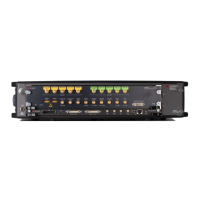Output path selection switch
Selects among the three output paths. Depending on this setting, the input fields
for offset and termination voltage are applicable or not.
DAC: Direct DAC output (optimized for best SFDR & HD, differential
output)
DC: Amplified differential output (optimized for serial data/time domain
applications, differential output)
AC: Single ended AC coupled output with up to 10 dBm output level
(optimized to generate high voltage, high bandwidth signals, single
ended, AC coupled output)
Sample Rate
Displays the sample rate depending on the clock source (external or internal).
Baseband Sample Rate
Displays baseband sample rate for interpolated mode i.e. sample rate divided by
the interpolation factor (3, 12, 24 or 48).
Only in up-conversion mode (interpolated mode) there is a difference between
baseband sample rate and (DAC) sample rate. The (DAC) sample rate is the rate at
which the DAC output samples. The baseband sample rate is the rate at which the
IQ data samples are fetched from AWG memory. The baseband sample rate is
always lower than the DAC sample rate and depends on the interpolation factor set
in the output panel (3, 12, 24, 48). For example for interpolation factor 3 it is one
third of the DAC sample rate.
Amplitude
Specifies the amplitude of the output signal.
Offset
Specifies the offset of the output signal.
Differential offset
Specifies an offset adjustment to compensate for small offset differences between
normal and complement output (see Differential Offset).
Reduced Noise Floor
Sets the “Reduced Noise Floor” feature. When the reduced noise floor feature is
enabled, there is less phase noise in the generated output signal.
The AWG has a delay adjustment in the module, that allows to add a delay to a
channel’s output signal (coarse delay, fine delay). Using the delay adjustment a
user can delay the signal on one channel compared to the signal on the other
channel, for example to compensate for differences in delay caused by different
cable lengths. He can also set a defined delay between the channels. The delay line
used for the delay adjustment adds phase noise to the output signal. When the
reduced noise floor feature is enabled, this delay line is by-passed. So we don’t
have this additional phase noise of the delay line, but we cannot use the delay
adjustment. Delay adjustment is also used internally, when signal generation is
started, to minimize the delay between channels. Since the delay line is by-passed
when reduced noise floor is enabled, this delay adjustment during start of signal
generation is less accurate.

